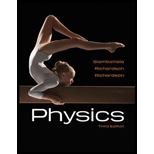
Concept explainers
(a)
What is the rocket’s altitude when the engine fails?
(a)
Answer to Problem 68P
Rocket’s altitude when the engine fails is
Explanation of Solution
Write the equation to find the displacement of rocket.
Here,
The initial velocity of rocket is zero, therefore, rewrite equation (I)
Conclusion
Substitute
Therefore, Rocket’s altitude when the engine fails is
(b)
When does the rocket reach the maximum height?
(b)
Answer to Problem 68P
The rocket will reach maximum height at
Explanation of Solution
Write the equation to find the final velocity of the rocket.
Here,
The final velocity of rocket is zero. Hence rewrite equation (I).
Conclusion:
Substitute
Therefore, The rocket will reach maximum height at
(c)
What is the maximum height reached by the rocket?
(c)
Answer to Problem 68P
The maximum height reached by rocket is
Explanation of Solution
Write the equation to find the maximum height reached by the rocket.
Here,
Substitute
Solve equation (II) to get
Conclusion:
Substitute
Therefore, The maximum height reached by rocket is
(d)
What is the velocity of the rocket just before it hits the ground?
(d)
Answer to Problem 68P
The velocity of the rocket just before it hits the ground is
Explanation of Solution
Write the equation to find the final velocity of rocket.
Here,
The initial velocity of the rocket is zero. Hence rewrite equation (I) to get
Conclusion:
Substitute
Therefore, The velocity of the rocket just before it hits the ground is
Want to see more full solutions like this?
Chapter 2 Solutions
Physics - With Connect Access
 College PhysicsPhysicsISBN:9781305952300Author:Raymond A. Serway, Chris VuillePublisher:Cengage Learning
College PhysicsPhysicsISBN:9781305952300Author:Raymond A. Serway, Chris VuillePublisher:Cengage Learning University Physics (14th Edition)PhysicsISBN:9780133969290Author:Hugh D. Young, Roger A. FreedmanPublisher:PEARSON
University Physics (14th Edition)PhysicsISBN:9780133969290Author:Hugh D. Young, Roger A. FreedmanPublisher:PEARSON Introduction To Quantum MechanicsPhysicsISBN:9781107189638Author:Griffiths, David J., Schroeter, Darrell F.Publisher:Cambridge University Press
Introduction To Quantum MechanicsPhysicsISBN:9781107189638Author:Griffiths, David J., Schroeter, Darrell F.Publisher:Cambridge University Press Physics for Scientists and EngineersPhysicsISBN:9781337553278Author:Raymond A. Serway, John W. JewettPublisher:Cengage Learning
Physics for Scientists and EngineersPhysicsISBN:9781337553278Author:Raymond A. Serway, John W. JewettPublisher:Cengage Learning Lecture- Tutorials for Introductory AstronomyPhysicsISBN:9780321820464Author:Edward E. Prather, Tim P. Slater, Jeff P. Adams, Gina BrissendenPublisher:Addison-Wesley
Lecture- Tutorials for Introductory AstronomyPhysicsISBN:9780321820464Author:Edward E. Prather, Tim P. Slater, Jeff P. Adams, Gina BrissendenPublisher:Addison-Wesley College Physics: A Strategic Approach (4th Editio...PhysicsISBN:9780134609034Author:Randall D. Knight (Professor Emeritus), Brian Jones, Stuart FieldPublisher:PEARSON
College Physics: A Strategic Approach (4th Editio...PhysicsISBN:9780134609034Author:Randall D. Knight (Professor Emeritus), Brian Jones, Stuart FieldPublisher:PEARSON





